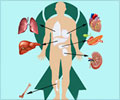Creutzfeldt-Jakob disease (CJD) is a rare and fatal neurodegenerative disease.
Creutzfeldt-Jakob disease (CJD) is a rare and fatal neurodegenerative disease. The disease is characterized by a rapidly progressive dementia associated, myoclonus and a characteristic electroencephalographic pattern. Although CJD appears to occur as a predominantly sporadic disorder it can also occur as a dominantly inherited or infective condition. CJD occurs worldwide with a roughly even incidence of between 0.5-1.0 cases per million per year.
In Britain, in the past 33 years, about seven cases of CJD were caused by transplanted tissue. All were caused by transplanted dura mater. It is the outermost membrane covering the brain and spinal cord, which is used by surgeons to repair the skull and spine and to reinforce tendons and ligaments.Richard Knight and his colleagues of the National CJD Surveillance Unit at Western General Hospital, Edinburgh, published the findings in the Journal of Neurology, Neurosurgery and Psychiatry. CJD arose between four and fifteen years after surgery and was traced to one German supplier in six cases. In the seventh, the source was traced to pig tissue.







